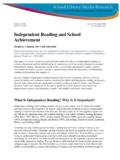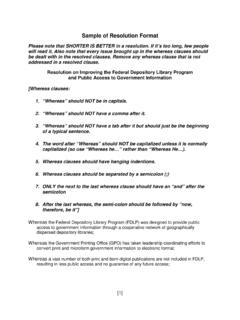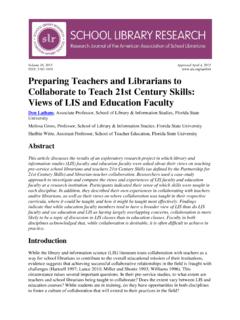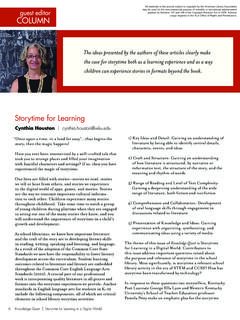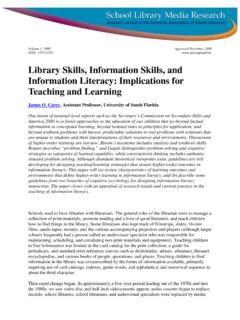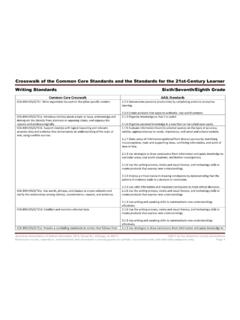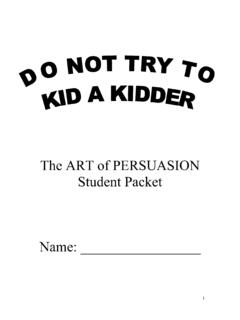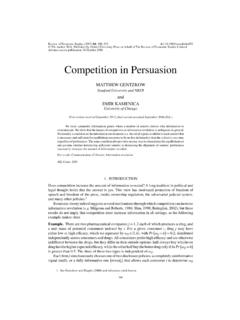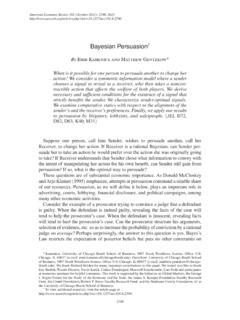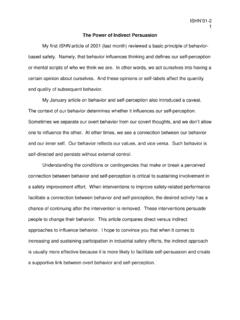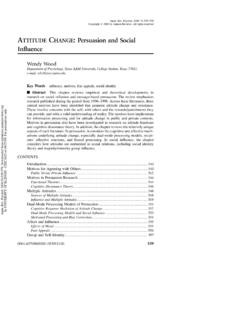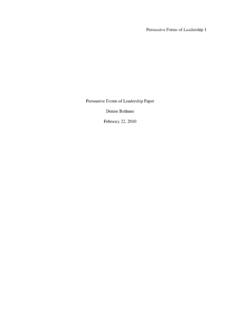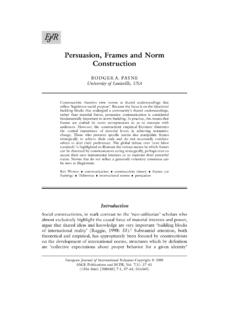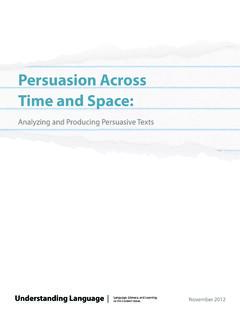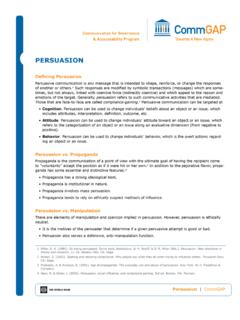Transcription of The Power of Personal Persuasion
1 ThePersonal Persuasion :ToolkitAdvancing the Academic Library Agenda from the Front LinesPower ofTheContents1 Toolkits: What Are They? How Does One Use a Toolkit? 2 Power in Organizations: Personal Power , Persuasion , and Leadership for the Frontline Academic Librarian and Library Worker 5 Establishing the Message: The Academic Library Agenda and the Imperative to Advance the Academic Library Agenda 9 Persuasion : Definitions and Techniques 16 Best Practices/Lessons Learned 17 27 Appendices 17 Appendix I Gathering Data to Support Messages/Training Content26 Appendix II Frontline Librarian and Library Worker Training Content 28 Resources Association of College and Research Libraries, a division of the American Library Association, my ACRL presidential year, my vision was to prepare frontline librarians and other library workers for grassroots library advocacy.
2 This would include developing their self-confidence and advocacy skills so they can advocate for their academic libraries on campuses, within academic departments and other campus units, within college and university faculty senate governance, and/or within the library itself. To that end, this toolkit is designed to provide participants with the knowledge, skills, and abilities to integrate Power and Persuasion into the toolkit is a result of an initiative designed to empower all academic librarians and library workers with the following skills: Ability to define their own Personal Power and a belief that they have Power and influence Knowledge that Personal Power is possible from the individual on the frontlines Ability to articulate how they can lead from the bottom or the front by determining how frontline librarians get permission to further the agenda; by identifying institutional mechanisms for individuals to deliver the message.
3 And by identifying techniques for delivering the message Ability to advance the academic library agenda by helping them to reflect on their own Personal circles of influence and the strategies that would be most A. ALIREACRL President, 2005 20061 ToolkitsWhat Are They? How Does One Use a Toolkit?The term toolkit is used to describe a structure or set of information and content to be used for a specific purpose. Tools or content elements in the kit are designed to provide a target audience not only content, but also diverse techniques for delivering content to meet project or purpose goals. These goals can include: vision, goals, strategies, and action plans; definitions and fact sheets; target audience identification; environmental scans; methods for small group and interactive real-time and asynchronous communication; contacts and forums for the toolkit audience; time lines; best practices; pathfinders; visuals such as flowcharts, graphs, paradigms, and paradigm shifts; organization and individual self-assessments; tutorials; learning modules; case studies; research; and archives and links to other relevant the opportunity to deliver toolkits through dynamic Web environments, the design of living toolkits greatly increases the diversity, depth, use, and value of toolkit content.
4 As education and training of frontline librarians expands from conference program training to programs and workshops throughout the states, this toolkit will be increased to include examples of: Content, in a variety of formats, prepared for individual institutions, states, etc. Best practices of processes for training frontline librarians Best practices of successes of frontline librarians in institutions Examples of academic library messages Case discussions of lessons learned as frontline librarians assess their current roles and refine, revise, and deliver messagesSpecific strategies for the toolkit include the following: Design basic and train-the-trainers content for academic librarians (learning module content to be presented through the toolkit as an advanced organizer, PowerPoint of content for delivery of message).
5 Define and provide content on Personal Power /the Power of one and the Personal Power of professionals in the workplace (scenarios, case methods, self-assessments). Define Persuasion and the role of Persuasion and presentation in advancing the agenda of the academic library (best practices, lessons learned). Identify and provide processes for nurturing and structuring mechanisms and networks in organizations for individuals to further the agenda and vision of the academic library and information environment (organizational self-assessments, best practices, paradigm shifts). Outline best practices and lessons learned on Power and Persuasion coming from the front lines in organizations in general and in library organizations (best practices, lessons learned).
6 Provide content on Power and Persuasion and how these organizational elements relate to leadership from the front lines (learning module content presented through advanced organizers, PowerPoints). Design processes for how one leads from the bottom or the front (best practices). Establish processes for frontline librarians to gain permission to further the academic library agenda (best practices, scenarios).2 Power in OrganizationsPersonal Power , Persuasion , and Leadership for the Frontline Academic Librarian and Library WorkerWhen researching Power and/in organizations, there is much professional literature on achieving Power , Power and leadership, and Power and influence. Discussion of Power in organizations, in general, focuses on: position Power versus Personal Power ; stages/types of Power ; steps for getting and keeping Power ; and how Power is different in different types of organizations and with different people (gender, age, etc.)
7 The researcher quickly finds out, however, that there isn t much out there connecting librarians to Power . What does come up frequently is the connection of libraries to Power , specifically, school libraries, with their use of the word Power in their national standards and their frequent use of knowledge is Power and information is Power . However, one should not jump to the conclusion that this means librarians in general or librarians other than school librarians don t have or seek Power . Quite the contrary, many librarians constantly and consistently strive for Power and to position themselves, their libraries, and, especially, access to their library resources and services in the legislative national arena as well as in the state, regional, local, and institutional legislative and many other reality is that, although the study of Power is important, few can expect to achieve positions of Power and few employees ever find themselves in positions where they can influence the success of their organization by assuming Power through their position or title.
8 Many believe that using Personal Power is an avenue for influencing the directions of organizations and focusing on Personal Power and influence; specifically, the technique of influencing others by using Persuasion techniques is recommended. Clearly, the primary responsibility for positioning the library within the institution typically rests with senior administration. In fact, when one reviews job descriptions, evaluation forms, communication plans, and marketing plans, to name just a few documents, most of the language does not focus on frontline librarians responsibility for internal outreach for the express purpose of positioning the library and advocating for the library and library resources and services. Clearly, frontline librarians have articulated responsibilities for outreach that include outreach to/for.
9 Decision-making groups such as curriculum groups, technology/Web groups, general planning, accreditation groups Discipline-specific faculty groups, including departments, divisions, task forces Faculty groups, including faculty senate Institutional standing committees such as academic deans meetings Institutional ad hoc committees such as new advising standards or registration issues Hiring groups Groups brought together for trainingHowever, this outreach is usually specific to a task at hand, such as library assignments integrated into the curriculum, planning for a new campus library, establishing library budget needs, or bringing librarian issues to a decision forum such as a faculty senate. Thus, frontline librarians are not typically charged to advocate for the library internally in general or specifically.
10 Everyone within the institution must realize that, within the institution, general advocacy and specific task-oriented advocacy must take place for the library to be in the best possible position for planning, budgeting, leadership, and management. How might this be realized? Managers should assess the organization s documents to ensure that: Internal advocacy for the library within the institution is included in all position job descriptions with specificity as to roles and responsibilities and necessary competencies. Advocacy roles and responsibilities are evaluated in librarian and library worker evaluations. Goals statements, either departmental or individual, should include advocating for/3positioning the library within the umbrella institution.
